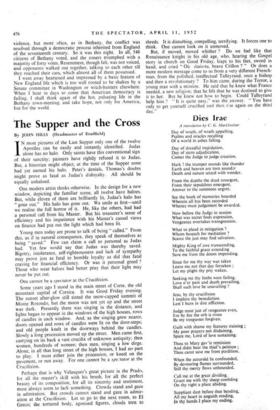The Supper and the Cross
By JOHN HILLS (Headmaster of Bradfield)
IN most pictures of the Last Supper only one of the twelve Apostles can be easily and instantly identified. Judas alone has no halo. Only saints have this conventional sign of their sanctity; painters have rightly refused it to Judas. But, a historian might object, at the time of the Supper none had yet earned his halo. Peter's denials, Thomas's doubts might prove as fatal as Judas's disloyalty. All should be equally unhaloed.
One modern artist thinks otherwise. In the design for a new window, depicting the familiar scene, all twelve have haloes. But, while eleven of them are brilliantly lit, Judas's halo has "gone out." His halo has gone out. We smile at first—until we realise the full horror of it. He, like the others, had had a personal call from his Master. But his treasurer's sense of efficiency and his impatience with his Master's casual views on finance had put out the light which had been lit.
Young men today are prone to talk of being "called." From this, as if in natural consequence, they speak of themselves as being "saved." Few can claim a call so personal as Judas had. Yet few would say that Judas was thereby saved. Bigotry, intolerance, self-righteousness and lack of sympathy may prove just as fatal to humble loyalty as did that fatal craving for financial efficiency. Or was it personal greed ? Those who wear haloes had better pray that their light may never be put out.
One cannot be a spectator at the Crucifixion.
Some years ago I stood in the main street of Corte, the old mountain capital of Corsica. It was Good Friday evening. The sunset after-glow still tinted the snow-capped summit of Monte Rotondo, but the moon was not yet up and the street was dark. Presently there was singing in the distance, and lights began to appear in the windows of the high houses, rows of candles in each window. And, as the singing grew nearer, doors opened and rows of candles were lit on the door-steps; and old people knelt in the doorways behind the candles. Slowly a long procession moved up the street. Men came first, carrying on its back a vast crucifix of unknown antiquity; then women, hundreds of women; then men, singing a low dirge. Alone, in all that long street of the high houses, I had no part to play. I must either join the procession, or kneel on the pavement, or run away. For one cannot be a spestator at the Crucifixion.
Perhaps that is why Velasquez's great picture in the Prado, for all the master's skill with his brush, for all the perfect beauty of its composition, for all its sincerity and sentiment, must always seem to lack something. Crowds stand and gaze in admiration. But crowds cannot stand and gaze in admir- ation at the Crucifixion. Let us go to the next room, to El Greco; the tortured body, agonised figures, clouds torn to _ shreds. It is disturbing, compelling, terrifying. It forces one to think. One cannot look on it unmoved.
But, if moved, moved whither ? Do we feel like that Renaissance knight in his old age, who, hearing the Gospel story in church on Good Friday, leapt to his feet. sword in hand, and cried "øü etais-tu, brave Crillon ? " Or does a more modern message come to us from a very different French- man, from the polished, intellectual Talleyrand, once a bishop and then a revolutionary ? To him came, during the Terror, a young man with a mission. He said that he knew what France needed, a new religion; that he felt that he was destined to give it to her. But he knew not how to begin. Could Talleyrand help him ? "It is quite easy," was the answer. "You have only to get yourself crucified and then rise again on the third day."


































 Previous page
Previous page